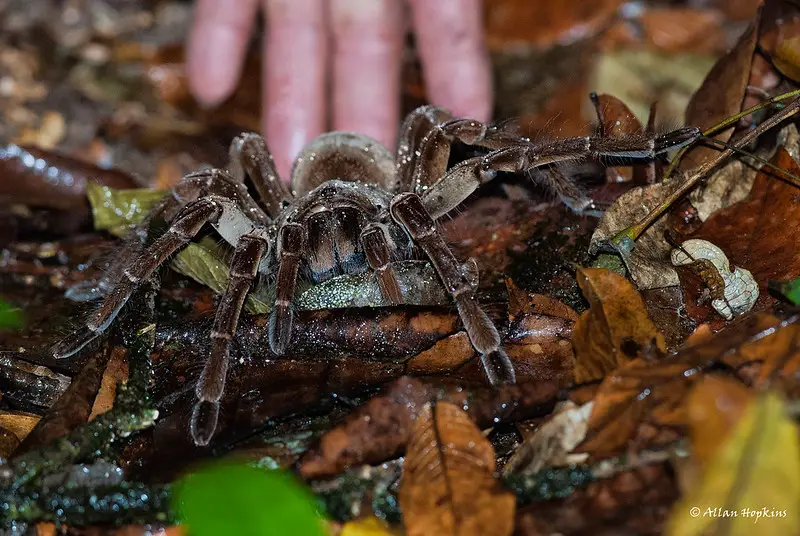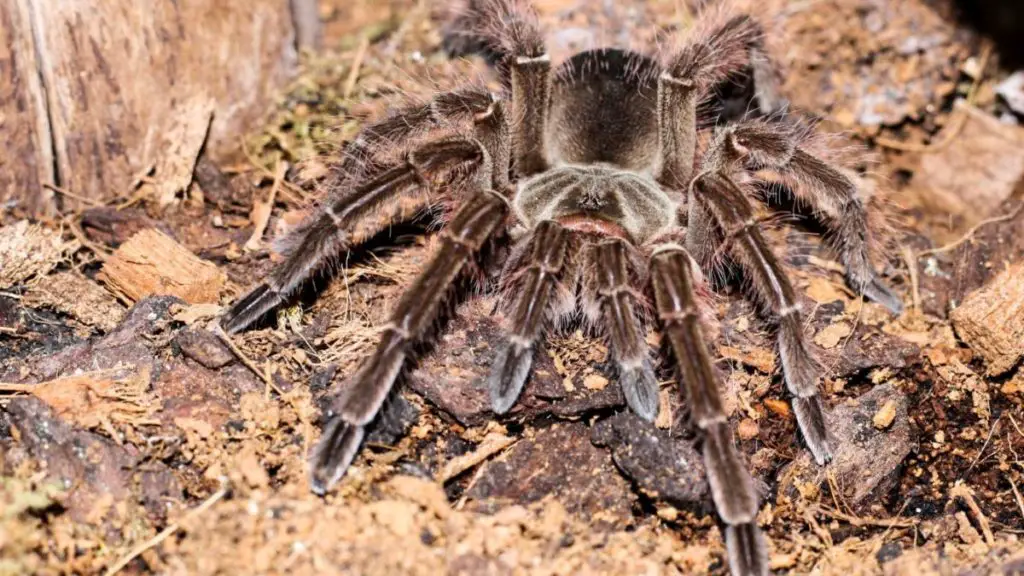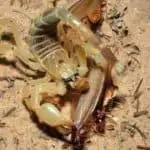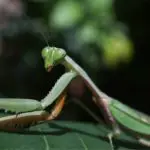Caring for goliath birdeater tarantula is not easy. In this guide, I’ll teach you all you need to know about goliath birdeater care, from purchasing, housing and feeding, to mold and mite management.
Basic Introduction
There are 2 common species of goliath birdeater tarantulas – Theraphosa blondi and Theraphosa stirmi. Both species are categorized as swamp dwellers, which requires more care than other beginner species. You shouldn’t keep goliath birdeater as a pet if you don’t have prior experience keeping tarantulas.
Theraphosa blondi
Known as the Brazilian goliath birdeater, Theraphosa blondi is the largest species of tarantula in the world. It can grow up to 12” in leg span! The female T. blondi have an average lifespan of 20-25 years. Males can only live for 3-6 years. Both male and female reach sexual maturity around 3-6 years old.
T. blondi is rather aggressive. They may bite with their huge fangs, or shoot volleys of urticating hairs if they are agitated. They can also make a loud hissing noise to warn their enemy.
Theraphosa stirmi
Theraphosa stimi is known as the Burgundy goliath birdeater. While it is slightly smaller than T. blondi, it can still reach 10-11″ in leg span! Male T. stirmi can live for 4-6 years, while the female can live for more than 20 years.
Unlike T. blondi, this species is more docile. It rarely bites, but it kicks urticating hairs when agitated.
Theraphosa blondi vs Theraphosa stirmi
Sometimes, T. stirmi can be confused with T. blondi. You will be able to differentiate them if you know the tricks.
The key differences between T. blondi and T. stirmi are on their legs. Theraphosa blondi spiderlings have brown tarsi, while the tarsi on the 4 front legs of T. stirmi are pale. On top of that, T. blondi has setae (hairs) on its knees and underneath of its femora, while T. stirmi doesn’t have both.
Here’s a photo of T. stirmi. Both the knees and underneath of femora don’t have setae or hairs.

Photo below is a T. blondi. Both the knees and underneath of femora are hairy.

Buying Goliath Birdeaters
You can buy goliath birdeaters from reputable breeders or sellers from Arachnoboards.
Theraphosa blondi is a rare species, mainly because it is difficult to breed in captivity. This makes it more expensive than T. stirmi. If you intend to buy a T. blondi, make sure it is a not a misidentified T. stirmi.
On average, it costs around $150-250 for a juvenile T. blondi, up to $500 for a male sub-adult, and up to $1000 for a female sub-adult. T. stirmi is 10-40% cheaper, depending on life stages. Not all spiderlings can survive into adulthood. Sub-adults typically have a higher survival rate.
Goliath Birdeater Enclosure Setup
Housing
Goliath birdeater is a huge species. You need a 20 gal long tank to house the adult tarantula. Some hobbyists may use a 10 gal tank, but it is often too crowded. A bigger tank gives you more space to manage your tarantula.
Don’t use a tall tank. Goliath birdeater is bulky and heavy. Falling from height may cause serious injury to the tarantula.
Because goliath birdeater requires high humidity, try to use a glass tank instead of an acrylic one. Acrylic sheet can warp after absorbing excessive moisture from 1 side, and create gaps for your tarantula to escape (read more about glass vs acrylic enclosure).
The goliath birdeater enclosure should also have some vents for ventilation. However, bear in mind that the more vents you have, the more difficult it is to maintain high humidity.
Make sure you get a secure lid for the tank. You don’t want your birdeater tarantula to roam freely in your house! Bricks are your best friend. You can also use rubber band, but you may end up having the leg of your tarantula stuck between the lid and the tank.
Avoid using lids with aluminum or nylon mesh. The goliath birdeater can easily bite through it.
Unfortunately, most commercially-available tanks are not tailored for goliath birdeater. They usually have a mesh lid. You will need to remove the mesh, and replace it with acrylic sheets. Drill some holes for ventilation before gluing the acrylic sheet with silicon. As mentioned earlier, the acrylic sheet may warp, but I can’t think of any better alternatives.
Leave the silicon to cure for 2-3 days before using the lid. You want to avoid any harmful volatiles emitted from the silicon glue to harm your tarantula.
Substrates
Use either coir or non-pesticide treated potting mix as substrates. Add water and mix evenly until the substrate is adequately moist but not wet.
Take some substrates, and hold it firmly. If the substrates hold its shape momentarily without dripping, it is good to go. If it is too wet (dripping when pressed), add more substrates.
Lay the tank with moist substrates, and press to compress them. The space between the lid and the substrate should not be less than half the leg span of your birdeater tarantula, and not more than the leg span.
Put a coconut husk or artificial cave for your birdeater tarantula to hide. If you plan to decorate the enclosure, use things that can tolerate moisture. Avoid using sharp decor.
Lighting
Like all other tarantulas, goliath birdeater doesn’t require additional lighting. They are nocturnal. It is OK to have 8-12 hours of ambient lighting. Keep them away from direct sunlight.
If you want to use display lighting so that you can observe your tarantula better, use red LED light. Tarantulas are not sensitive to red light, and hence, using red light will not cause much disturbance. However, red light is likely more expensive than white light.
You shouldn’t leave the lighting on for too long, especially if you are using white light. Turn off the lighting once you are done observing your tarantula.
Temperature
Keep your goliath birdeater at 80-90 °F (27° to 32°C), if possible. If not, they can also do well at room temperature.
Some people prefer to put the tarantula in a closed cabinet, and heat up the air in the cabinet. Simply put the heat mat beside the tarantula housing, or use a warm light to generate heat. Block the light with cardboard to keep your tarantula in the dark.
You can also place the heat mat directly under a corner of the tank. This will create a heat gradient across the tank, and your tarantula can relocate itself to the most comfortable spots. Monitor the temperature closely so that you don’t kill your tarantula by overheating it.
If you are providing extra heat to your tarantula, pay attention to the humidity in the housing. The extra heat will make the water in the substrates evaporate faster. You might need to replenish the water more frequently.
The rate of metabolism will be faster if your tarantula is kept at a higher temperature. This means your tarantula will grow (age) and get hungry faster when kept at a higher temperature.
Humidity
Goliath birdeaters are swamp dwellers. They need high humidity for survival. Such a level of humidity can be achieved by providing a water dish, watering the substrates, and minimizing ventilation.
Make sure the water dish is not too deep. Otherwise, feeders may drown inside. Put some pebbles in the water dish, so that the feeders can escape from drowning.
On a regular basis, water the substrates and refill the water dish so that the enclosure is humid enough. Keep the substrates moist (again, not wet), and it is all good.
Some people may advise minimizing the ventilation by sealing the vents to maintain the humidity. The lesser the vents, the easier it is to maintain humidity, and the less frequent you need to water the substrates.
While reducing ventilation can keep the humidity high, it can also promote the growth of molds. Moreover, the lack of ventilation and excessive humidity can kill your goliath birdeater. In fact, many captive goliath birdeaters suffer from excessive humidity rather than dryness.
If you see condensation in the enclosure, it is a sign of excessive moisture and insufficient ventilation. Ventilate the enclosure and let the substrates dry out a little bit.
You can also invest in a humidifier to keep the enclosure humid.
Feeding
Feed your juvenile goliath birdeater with 2-4 crickets twice a week. Slowly reduce the amount of feeding to 4 crickets or 1 Dubia cockroach a week as it grows into adult. You can also feed it with mice, which are more expensive.
The actual amount of prey consumed may vary by sizes and individual tarantulas. Remove unconsumed prey after 3-4 days, or if your Theraphosa shows signs of molting. If you are feeding mice to your goliath birdeater, watch till the tarantula seize the mouse. I wouldn’t let the mouse roam freely in the enclosure.
For the safety of your tarantula, don’t feed it with anything bigger than its opisthosoma.
If you have issues feeding your tarantula, check out the reasons why your tarantula is not eating.
Molting Care
The care for goliath birdeater during molting is the same as other tarantula species. Refer to my guide on molting care.
Breeding
Breeding the goliath birdeaters is difficult, especially for T. blondi. While the female goliath birdeater typically doesn’t consume the male, she often eats her offspring.
Refer to my guide on tarantula breeding if you are keen to try.
Cleaning the Enclosure
Every time your goliath birdeater finishes eating, you should do a cursory cleaning to remove any leftovers. This will prevent, or at least defer the growth of molds and attraction of other pests.
You should do a thorough cleaning of the enclosure once or twice a year. Don’t do it too often (unless you absolutely need to), because goliath birdeater dislike disturbance, and needs time to acclimate.
In the thorough cleaning, you need to discard all the substrates, wash the enclosure with soap, and lay new substrates.
If you have any decors in the enclosure, brush them clean. Wearing gloves when cleaning can help reduce the chance of getting hurt by the urticating hairs.
Consider keeping isopods together with your goliath birdeaters. Isopods are good clean-up crews that can remove the leftovers in your tarantula cage. They do not bother your tarantula, and live well in the birdeater tarantula setup.
Transferring Goliath Birdeater for Cleaning
Carefully transfer your goliath birdeater into another tank, so that you can do the thorough cleaning.
For convenience sake, use a container with a big enough opening to cover the tarantula from the top. Once you’ve covered it, slowly slide the lid from underneath to trap the tarantula. If you don’t have a suitable container, you will have to coax your tarantula into the container.
Try to get a transparent container with a transparent lid. Things like a transparent shoe box or candy box can be used. This allows you to see where your tarantula is and what it is doing to avoid surprise.
Tackling the Molds
In reality, you may need to do thorough cleaning more often, because the goliath birdeater enclosure is susceptible to molds (and mites).
When you notice molds in the enclosure, relocate the tarantula and clean the enclosure thoroughly. Old substrates should be disposed of, and replaced with a new one.
Consider keeping woodlice or pill bugs (affiliate link) with your pet tarantula. Pill bugs are small creatures that thrive in moist environments. They are scavengers, and do no harm to your goliath birdeater. They aren’t the preferred food of your pet tarantula either.
Many hobbyists were able to deter molds by keeping pill bugs together with their tarantula. No special care for the pill bugs is required. As long as you keep the enclosure humid, those pill bugs will survive.
You don’t need to feed the pill bugs either. They will eat on whatever decaying materials they find in the enclosure.
Be Weary of Fungal Infection
Because goliath birdeaters live in a moist environment, they may catch fungal infection on their tarsi or the underside of their body. These 2 body parts are often neglected, because they aren’t conspicuous.
On a regular basis, move your tarantula into a transparent container to see if there is any fungus underneath its body and on the tarsi. The fungal infection may resemble a cottony patch, or appear as a gray spot.
If you aren’t sure, re-inspection your tarantula after 2-3 weeks to check if the size of the affected area is growing. If it is growing, it is likely a fungal infection.
To treat the fungal infection, you can buy some antifungal lotion from the pharmacy. Using a cotton swab, carefully apply the lotion onto the affected spot. Bear in mind that none of the antifungal lotions are tested for tarantulas. So, use it at your own risk.
Unfortunately, your tarantula will not stay still and let you do your job. To make your life easier, poke multiple holes on all walls of the transparent container that you use to relocate your tarantula.
When the tarantula is placed inside, you can apply the antifungal lotion using a cotton swab, through the most suitable hole without getting bitten.
Dealing with Mites
Having a mite infestation is a common challenge for Theraphosa owners.
It is almost inevitable to have mites, because you introduce mites whenever you feed your tarantula with crickets or roaches. But, this issue becomes more apparent in goliath birdeater enclosure due to the humid environment, which is conducive for mites.
Mites appear as tiny little moving dots. They are active at night. If you see many tiny moving dots in the enclosure, you have to deal with it immediately. If not, your goliath birdeater will eventually die. How mites kill tarantulas is unknown though.
To get rid of mites in the tank, move your goliath birdeater out of the mite-infested tank. Dispose of the contaminated substrates, and wash the tank with soap. Lay new substrates, and put your tarantula back to the tank.
Some mites may stay on the body of your tarantula. That’s OK. You don’t have to brush or wash them off. You are going to reintroduce mites anyway, when you feed your tarantula.
Consider adding some predaceous mites (affiliate link) into your enclosure, if you have trouble getting rid of the mites. The predaceous mites will attack and kill the pesky mites in the enclosure for you.
Both predaceous mites and your tarantula can live together in harmony, without harming each other.
Recommended Supplies
Here are my recommended supplies that you can consider for keeping birdeater spiders. Note that I get a small commission when you buy the items through the links in this page. This helps me maintain the site without incurring additional costs to you.
Final Words
Keeping a goliath birdeater is challenging, but rewarding. I hope the information shared here is useful for those who want to start keeping T. blondi or T. stirmi. If the care regime for T. blondi or T. stirmi is too tough, Lasiodora parahybana is a good alternative. Do check out my recommended books on tarantula keeping if you want to learn more about tarantula keeping.


